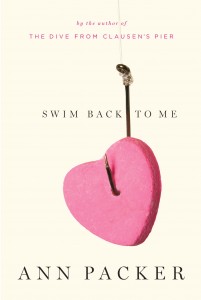 We love short stories. (Maybe it's our ADD-esque personalities?) There's something about reading a great story and knowing that when it comes to the end, you get more! And when we read Swim Back to Me by Ann Packer, a collection of short stories and a novella, we each felt like a kid at her birthday party, excited about the present we were opening but equally excited about what we'd get to unwrap next. Because once you become absorbed in New York Times best seller Ann Packer's writing, you quickly realize you want more and more and more. But even Swim Back to Me eventually had to come to an end. So we definitely plan to check out Packer's other works including her award-winning and best selling novel, The Dive from Clausen's Pier and another collection of short stories, Mendocino and other Stories.
Synopsis of Swim Back to Me: There's the story of the wife struggling to make sense of her husband's sudden disappearance. A mother mourning her teenage son through the music collection he left behind. A woman shepherding her estranged parents through her brother's wedding. A young man coming to grips with the joy- and vulnerability- of impending fatherhood. And, in the opening novella, two teenagers from different families- one a tightly knit foursome, the other a father and son who share little more than having been abandoned by the same woman- forge a sustaining friendship, only to discover the disruptive and unsettling power of sex.
We love short stories. (Maybe it's our ADD-esque personalities?) There's something about reading a great story and knowing that when it comes to the end, you get more! And when we read Swim Back to Me by Ann Packer, a collection of short stories and a novella, we each felt like a kid at her birthday party, excited about the present we were opening but equally excited about what we'd get to unwrap next. Because once you become absorbed in New York Times best seller Ann Packer's writing, you quickly realize you want more and more and more. But even Swim Back to Me eventually had to come to an end. So we definitely plan to check out Packer's other works including her award-winning and best selling novel, The Dive from Clausen's Pier and another collection of short stories, Mendocino and other Stories.
Synopsis of Swim Back to Me: There's the story of the wife struggling to make sense of her husband's sudden disappearance. A mother mourning her teenage son through the music collection he left behind. A woman shepherding her estranged parents through her brother's wedding. A young man coming to grips with the joy- and vulnerability- of impending fatherhood. And, in the opening novella, two teenagers from different families- one a tightly knit foursome, the other a father and son who share little more than having been abandoned by the same woman- forge a sustaining friendship, only to discover the disruptive and unsettling power of sex.
Swim Back to Me was unlike anything we've read in a while- with unique short story after unique short story, it was an exciting departure from the novels we usually love to read. And we reminded ourselves that it's always good to switch things up from time to time. Don't you agree? Read an excerpt of "Walk for Mankind" from Swim Back to Me here.
And if you leave a comment, you'll be entered to win one of five copies of Swim Back to Me. We'll randomly select the winners after 6pm on Thursday, April 21st.
 CHICK LIT IS NOT DEAD PRESENTS...ANN PACKER'S 5 DO'S AND 1 DO-OVER
CHICK LIT IS NOT DEAD PRESENTS...ANN PACKER'S 5 DO'S AND 1 DO-OVER
"This format of 5 Do’s and 1 Do-over struck me as tailor-made for an interview about my new book, since it, too, has a 5 + 1 structure—five short stories and one novella. So, without further ado, here are my 5 + 1, with a literary twist."- Ann Packer
DO
1. Stay open to beauty. Back in the 90s, when my kids were little, I didn’t listen to much music outside the oeuvre of Raffi, that genius of the children’s song, who wrote such immortal lyrics as
Down by the bay
Where the watermelons grow
Back to my home
I dare not go.
For if I do
My mother will say
“Did you ever see a moose
Kissing a goose?”
Down by the bay
Then one day, when the second baby was old enough to take a bottle and I could be gone for a few hours, I began to teach a writing class. And one of my students, perhaps sensing a starvation so profound that not even the starved person herself knew about it, began making me mix tapes from his vast collection of rock ‘n’ roll. Within the space of a few months he’d initiated me into the glories of such eclectic acts as the Velvet Underground and the Violent Femmes, Pavement and the Pixies. I listened to my tapes constantly, with the volume way loud. And later, when “Molten,” a story about a grieving mother began to come to me, I knew just what she’d spend her time doing.
2. A fleeting thought may be just that, so write it down. Lately, I find myself going from my kitchen into my study, ready to do something on my computer, whether it’s send an email or Google someone or something else. Then I get there and I have absolutely no idea what I meant to do. Writing yourself a note on the way from the kitchen to the study may seem extreme, but, hey, whatever works. I may be in this habit because I sometimes get an idea for a story—something new or something already underway—and I used to play a game of chicken with myself: something along the lines of, Well, if it’s worthwhile I’ll remember it. Uh uh. I take no chances. And it pays off. I was the birthday party escort for a group of 14 year-old-boys going out for burgers, and so naturally I sat by myself at a table for one, not at their table. And in one of those rare creative moments, I began to imagine a young woman late at night, in a dark parking lot, her car dead. And I took out a teeny tiny notebook and, as the boys stuffed French fries into their mouths and debated the Giants’ lineup for the next game, I wrote the first six pages of “Jump.”
3. Explore your surroundings. We’d lived in our house for ten years on the day my son arrived home on his bicycle with a huge grin on his face and told me about the hill at the north edge of town where he and his friend had ridden their bikes that afternoon. He knew exactly how to describe where they’d been, and the next time we were driving in that area he very carefully pointed out the roads they’d taken, describing which were very steep, which stopped in dead ends. This was not exactly on my mind when I drove to Auburn, CA, one morning, to explore the town I’d already used as a setting for “Dwell Time.” But as I went up and down the streets, I thought about how believing you know a place, or can guess what it’s like, will never be the same as knowing it. The “scouting” trip resulted not only in better descriptions of the places my characters lived; it also delivered me to a river-side spot outside of town that became a key metaphor for the story.
4. Understand that the truth has consequences. When I was pregnant with my first baby, I attended a childbirth class at which the teacher asked everyone to go around the room and describe any previous experience with childbirth—had we been with a woman during labor, had we perhaps even attended a birth? People gave about the responses you’d expect, until it was the turn of the last woman in the room. She told us she’d gone through childbirth once herself, when she was married to someone else, and that her baby had died. The room went silent, and it could have gone either way: her revelation might have tilted the entire group into a fatal politeness, or it might have begun to dissolve the web of awkwardness inevitable in a dozen couples with nothing in common except their unreadiness for the greatest change life can bring. Years later, I began to wonder how that same piece of information—intimate, terrifying, immeasurably sad—might play out not within a group, but in a single couple. I used that question to start writing “Her Firstborn.”
5. Rely on poetry. I spent a long time working on “Things Said or Done,” trying to figure out who the characters were—to each other and also to themselves. I use a lot of dialogue to create character, because I think it’s in how we talk that we establish who we are. The middle-aged woman and her elderly father who are at the center of this story are great talkers—they banter and bicker and generally stay engaged with each other through all kinds of emotional fluctuations. He is a former English professor, so at one point, feeling something was missing, I began looking through a book of poems by WB Yeats, thinking there might be a good line for him to quote to her. Sure enough, I found some lines that seemed just right. And as I typed them into my document, knowing they not only fit his character but also reflected some central issues in their relationship, I remembered something I have remembered many times over the decades since I was an English major: that in poetry there is all of life, expressed in words you’d never have known yourself.
DO-OVER
Start over. How often do you get halfway into a project only to realize there is something terribly wrong with it? This can be as minor as pouring batter into a cake pan you forgot to butter or as momentous as discovering five years into your career in sales that you should have been a teacher. Occasionally in my work, I have gotten very far along and realized I’ve made an apparently fatal error. With my first novel, I was using a third-person narrator when in fact the story needed to be told in the first person, by the character herself. (And believe me, fixing this was not going to be a matter of doing a find and replace on “she” and “I.”) Writing “Walk for Mankind,” the novella that opens Swim Back to Me, I had an exciting new family moving into the neighborhood of an unhappy thirteen-year-old. That’s what I still have. But back when I was doing the first draft, the thirteen-year-old was a girl. And the novella just wasn’t happening. Then one day I thought, What if it were a boy to whom all of this was happening? Within days, I’d written forty or more pages, and while I can’t say it was smooth sailing all the way to the end—it never is—making that one major change made all the difference.
To find out more about the lovely and talented Ann Packer, visit her website and follow her on Facebook.
Thanks, Ann! xoxo, L&L
